Note: This is Day 4 of “The Whispered World Week” at The Slowdown.
It has been a while, has it not?
Not only is this game a long six years in the coming, but we have also not been treated to a high-resolution, 100% hand-drawn point and click adventure game in aeons, as even The Biller’s painterly A Vampyre Story and Pendulo Studios’ latest stylised offerings have resorted to 3-D in justified attempts at providing relief to the heavily budgetary nature of animation. And who could, in their right mind, blame them for doing so?
But still – one hundred percent. In light of the above games, that striking statistic alone makes Marco Hüllen’s The Whispered World stand out from the pack – and boy, does it ever: There is a breathtaking array of various character animations – actions, emotions, expressions and movements – that quite possibly has not been seen before, at the very least not since the heyday of the genre in the latter part of the 1990’s.
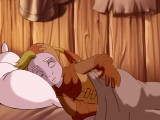 Perhaps the closest touchpoint in terms of the game’s graphical look and feel, then, is not to be found in the gaming medium at all, but among lead artist Hüllen’s primary influences: Japanese anime and classic children’s animations, like Spirited Away and The Last Unicorn (a cut-scene example on the left)?
Perhaps the closest touchpoint in terms of the game’s graphical look and feel, then, is not to be found in the gaming medium at all, but among lead artist Hüllen’s primary influences: Japanese anime and classic children’s animations, like Spirited Away and The Last Unicorn (a cut-scene example on the left)?
As things stand, every forthcoming review of the game will surely be gushing all over the graphics in the manner above. Therefore, we should probably move away from discussing the Captain Obvious -grade graphical prowess of the game and instead touch upon other aspects of the demo, the aspects that may potentially set the game apart from its counterparts.
What? Right, sure, yes, it is a generously budgeted adventure game – you’re right in your assessment in that we don’t get those too often, either. But what I meant to venture is that video games have seldom, if ever, touched upon the rather cruel existential position of the circus performer (For your information, The Secret of Monkey Island does not count! Cirque de Zale just might); the showmen and -women of the circus find themselves perpetually outside society, bound to their work and travel, only getting glimpses of normality in their day-to-day life.
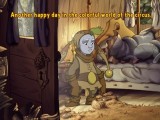 Sadwick the clown, the protagonist of The Whispered World, is clearly in the throngs of an inverted Wanderlust, aching to be rid of the travelling life, wishing nothing more than to escape into normalcy. While the unwilling protagonist as hero -set-up is theoretically nothing short of a video gaming staple, the marked difference here in practice is that though Sadwick may be extremely resistant to his current lot in life, he exhibits very little reluctance over his role in the grander scheme of things, and is ready to embrace anything that should break the boundaries of his current existence.
Sadwick the clown, the protagonist of The Whispered World, is clearly in the throngs of an inverted Wanderlust, aching to be rid of the travelling life, wishing nothing more than to escape into normalcy. While the unwilling protagonist as hero -set-up is theoretically nothing short of a video gaming staple, the marked difference here in practice is that though Sadwick may be extremely resistant to his current lot in life, he exhibits very little reluctance over his role in the grander scheme of things, and is ready to embrace anything that should break the boundaries of his current existence.
Sadwick would give everything to become a pira… someone, anybody, and in the demo, he indeed tries his very meek best to find a way out of his current position, out of acting as a human cannonball. Whether it be poetry or philosophy, though, his suggestions are rather mercilessly shut down, utilizing a perfunctory capitalist logos, by his family.
As soon as it is revealed that Sadwick has actually been assigned the role of the clown from the outside, forced to comply with the wishes of the rest of his entourage, it also becomes clear that we’re not really controlling the archetypal clown; instead, we’re playing a young man that has been involuntarily marked, classified and, in the process, nullified; it’s no surprise that Sadwick is trying to find ways of becoming more of a non-clown, a non-entity.
Often, you will find other characters in the game remarking on his failures as a clown, and in many ways, this is what Sadwick wants, even desires: The closer to a real clown he gets, the more he loses grip on his true identity. A contradictory one.
Though young Sadwick is presented rather dangerously in a high-pitched, nasal voice, the character ultimately comes across as sentimental and understandable instead of merely whiny and annoying, and the actor cast in Sadwick’s silly boots fills them rather admirably. Like so many existentialists in their youth (or is that youths in their existentialism?), Sadwick does seem to exhibit the side-effects of a tube vision, and subsequently comes off as single-minded in some instances, multi-faceted in others, ultimately promising enough variation and depth for the character to remain intriguing.
In fact, merely over the course of the demo, the voice actor behind Sadwick’s buffoonish façade clearly gets more comfortable in his role, loosens up and becomes more enjoyable to listen to, even if the game’s writing sometimes gets a little over-the-top verbose. Then again, players are free to click through dialogue as they please, as the game delightfully supports both line-skipping and double-click quick-exits – two elementary, baseline features that all adventure games should come with.
I can’t speak for the writing of the German version of the game, but the English-language translation comes off as both competent and polished, and perhaps offers to us a partial explanation to the rather long delay in-between the EU and US releases and the German release date.
Some of the wordplay (“compass-compote-complot-compost” – ugh!) might strike you as stilted, and its tone is often, uh, as the game would put it – loquacious. Overall, creating a successful sense of being in a completely new fantasy world, a sense of belonging, always requires more contextualization than other genres. That is the baggage of fantasy, and indeed suits some players better than others, just like fantasy literature suits different readers. Be that as it may, The Whispered World is certainly successful in making its world understandable and intriguing, and any adventure that attempts proper dialogue-based puzzles should be lauded for even trying.
For those who prefer their games voiceless, there also exist subtitles; both features can be turned on and off at will. There is little to say of the soundtrack at this juncture except that it is both outstanding and Hisaishi-like, contributing to the overall atmosphere.
In Wednesday’s interview, Hüllen emphasised how Sadwick’s character was redesigned to better appeal to adult players and convey a broader spectrum of emotion. It is incredibly easy to write both these attempts down as successes. Many of the added character animations have a profound effect on the game and its player, and I only need to show you two sequential screenshots to perfectly illustrate what the artist means:
There is a depth of expression, beyond the more common narrative means here, that often remains untapped in games; as I showed these images to Artful Gamer‘s Chris Lepine, he remarked that the team at Daedalic had seemingly very much succeeded in capturing “the miyazaki-style focus on simple/effective facial expression.” 1)http://twitter.com/ChrisLepine_AG/status/12527383410
The demo, which contains a section from the very first of the four chapters of the game, is set in the Autumn Forest location and is elegantly orchestrated overall, with unobtrusive restrictions in place, and allows players to experience enough of the game while still leaving enough locations untouched to engage players’ wallets.
For one, the download is one of the longer adventure game demonstrations that I’ve seen, and definitely offers a good few hours of active playtime as well as a brain-crunching challenge. The installer weighs in at 593mb and can be acquired from Deep Silver at this address. The full game is out tomorrow in Europe, and on Monday in the United States. So far, the game is digitally available at Direct2Drive, GamersGate and The Adventure Shop. Daedalic also promise a release on Steam. 2)http://twitter.com/daedalic/statuses/10881762668
References
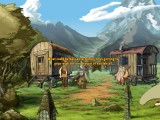
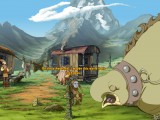
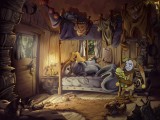
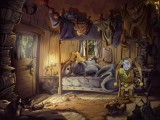
“Not only is this game a long six years in the coming, but we have also not been treated to a high-resolution, 100% hand-drawn point and click adventure game in aeons”
Machinarium?
Haha, that’s a tough cookie. I’ll have to agree to disagree with you on that, but the matter comes down to my opinionated definition and distinction instead of being right or wrong: In this story, I tried to really emphasise the “hand-drawn” aspect, and since Machinarium is done in Flash, it primarily utilizes motion tweening instead of, uh, “hand-drawn” animations.
That’s why the game is not mentioned. That being said, I don’t actually know how TWW was animated, but it certainly carries with it a superior range of expressive motion.
Having to justify the omission of Machinarium here in this way does make me feel like I’m utilizing a backwardly method, as the obvious idea of this story – as well as this whole week – is not to exclude or play favourites, but to illustrate how special it is to have something like these two games in this day and age.
So there, the method explicated. Feel free to disagree! If anyone has other examples – I’ve quite probably skipped over something else, too.